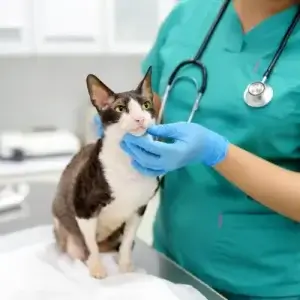Home / Compare Pet Insurance / Compare accident-only pe…

Key takeaways
- Accident-only pet insurance is the most basic level of cover available. As such, it’s also generally the cheapest.
- Accident-only pet insurance may cover your pet for injuries like wounds, snake bites and fractures.
- Even though accident-only pet insurance is the most basic level of cover, there may still be useful policy features and benefits available for you to use, such as your choice of treating vet, benefit percentage and optional extras.
Expert tips on accident-only pet insurance
Compare the Market’s pet insurance expert, Adrian Taylor, has a few tips for pet owners looking into accident-only pet insurance for their furry friend.

Know your policy’s limits
Pet insurance policies generally pay up to a certain percentage of your pet’s medical bills – meaning you’ll have to pay the rest. Knowing your policy’s benefit percentage can help you prepare in advance of receiving the vet bill.
Choose your excess
If your accident-only policy offers this option, you may be able to choose your policy’s excess. If you pick a higher excess, your premium may decrease, and vice versa. Be sure to pick an affordable amount in either case.
Compare policies annually
It’s a smart idea to compare accident-only pet insurance policies at least every 12 months, when your policy comes around for renewal. That way, you can see how your current policy compares against others on the market, including any new deals that may be available.
What is accident-only pet insurance?
 Pet insurance with accident cover can help pay for some of your eligible vet costs or emergency care if your pet has an accident or suffers an injury. It does not cover illnesses.
Pet insurance with accident cover can help pay for some of your eligible vet costs or emergency care if your pet has an accident or suffers an injury. It does not cover illnesses.
Accident-only cover is considered the most basic level of pet insurance as it has fewer benefits and lower limits compared to other types of pet insurance. For example, accident-only policies may not offer optional extras and may have a lower annual claim limit. So, if your pet is no stranger to danger and you think you might claim a few times a year, you may want to consider a pet insurance policy with higher coverage and limits, like accident and illness pet insurance.
Most insurers define an accident − or accidental injury − as physical harm your pet suffers in an unexpected or unplanned event/incident. Claimable accidents for pet insurance are unrelated to any other causes or illness, including chronic and pre-existing conditions. Most insurance companies won’t cover injuries resulting from negligence or malicious intent.
Accident-only pet insurance coverage
What does accident-only pet insurance include?
An accident-only pet insurance policy can help cover specified accidental injuries, such as:
- Car accidents
- Ingestion of foreign objects
- Poisoning
- Burns or electrocution
- Bone fractures
- Cuts and lacerations
- Bite wounds or fight wound abscesses
- Snake bite toxicity
- Allergic reactions to insect or arachnid bites
- Eye, nail and mouth injuries.
Inclusions and benefit limits may vary depending on your specific policy and insurer, so be sure to check your policy’s Product Disclosure Statement (PDS) to find out what you’re covered for.
What does accident-only pet insurance not include?
Accident-only pet insurance doesn’t cover illnesses. Other common exclusions that apply to most pet insurance policies include:
- Elective treatments
- Treatment for vaccine-preventable diseases (unvaccinated pets can still receive coverage for other treatments)
- Behavioural problems
- Breeding and pregnancy
- Dental illness and treatments
- Pre-existing conditions.
Keep in mind that some insurers offer optional extras on more comprehensive accident and illness policies that provide a benefit towards treatments commonly excluded from accident-only policies. This may include cover for vaccinations and routine care procedures like de-sexing, worming and dental care.
Which animals can I cover with an accident-only pet insurance policy?
Most insurers will offer pet insurance cover for dogs and cats. However, if you want to cover a different animal (like a horse), you’ll need to seek a policy from a specialist insurance provider.
Remember that certain dog breeds are banned in Australia and therefore won’t be covered by pet insurance, including dogs considered dangerous by authorities. Additionally, pets used for commercial purposes will not be covered.
How it works
Pet insurance features and benefits
 Pet insurance coverage and benefits will differ between insurers, but you can generally expect a policy to include the following:
Pet insurance coverage and benefits will differ between insurers, but you can generally expect a policy to include the following:
- An annual limit. The majority of pet insurance products have an annual benefit limit, which is the maximum the insurer will pay in any policy period. The annual limit is subject to exclusions, conditions and sub-limits.
- Choice of vet. Most insurers will let you go to a vet of your choice to treat your pet, while others may ask you to use a vet they nominate.
- A benefit percentage. All pet insurance products will include a benefit percentage, typically ranging from 70% to 90% (but some policies may be lower or higher). The benefit percentage is the amount of the bill your insurer will cover after the excess is deducted, and the remaining amount will be your gap payment. Some insurers will apply the policy excess before the benefit percentage, while other insurers will apply it after.
- Ability to insure more than one pet. Some insurers will allow you to insure multiple pets under one policy, and some may even offer ‘multi-pet’ discounts for those with more than one fur baby. Keep in mind that you may need to pay an additional premium to cover more than one pet.
- Cover for life. If you insure your pet before they reach the insurer’s nominated maximum age limit (usually nine years old) and maintain that cover continuously, your insurer may cover your pet for their whole life. However, the cost of pet insurance may still increase as your pet ages.
- Optional extras. Depending on the insurer and your policy, you can include optional covers for extended benefits in your accident-only policy. Keep in mind that including optional extras like routine care in your policy will add to your premium.
How much does accident-only pet insurance cost?
The premium you pay for your accident-only pet insurance will likely differ from what other pet owners pay for their policies. This is because premiums are calculated using factors unique to you and your pet, like the level of cover you’ve chosen and your pet’s age, breed and health status.
If you’d like to find out how much accident-only pet insurance might cost, you can get a quote via our pet insurance comparison service.
What to consider when you’re insuring your pet with accident-only cover
Your pet’s needs
Your pet’s age, current health status and medical or claims history are all factors that can affect the cost of premiums and the policies available to them. You may feel that your pet needs protection for more than just accidents and may instead benefit from a more comprehensive pet insurance policy.
Excesses and out-of-pocket expenses
An excess is an amount you need to contribute to any claim on your pet insurance and this will be listed in your policy schedule. Other common out-of-pocket expenses are usually due to the policy’s benefit percentage; after the insurer applies the benefit percentage, you will need to cover the balance of the vet’s bill.
While an excess is a fixed amount you pay for each claim, other out-of-pocket expenses will change in line with the total cost of the vet bill.
Waiting periods
Waiting periods don’t typically apply to accidental injuries (which means you’re covered from when you buy your policy), but most health conditions and illnesses covered under a combined policy have applicable waiting periods on claims unless stated otherwise.
For example, you may only be able to claim on cruciate ligament conditions once a certain amount of time has passed (e.g. six months). This can vary from insurer to insurer so make sure to review your PDS for exact details.
If you’re looking to get your pet covered for illnesses, you can read about accident and illness cover and comprehensive coverage in our guide to different types of pet insurance.
Pre-existing conditions
Most insurance providers will consider any symptoms or health conditions present before the commencement date of your new pet insurance policy as pre-existing conditions, meaning they’ll be excluded from cover. However, some insurers may cover pets with pre-existing conditions that have been cured or resolved for some time, usually for a minimum of 12 months.
Insuring your dog or cat when they’re young and healthy (or at least within their first year) means they’re less likely to have pre-existing conditions that won’t be covered. This is particularly important if your pet’s breed is known to have hereditary issues.
Meet our pet insurance expert, Adrian Taylor
As a General Insurance expert with over 13 years’ experience in financial services, Adrian Taylor knows that dogs and cats get themselves into all sorts of mischief. One part of Adrian’s work is to help empower consumers to understand how pet insurance can help save them from exorbitant vet bills when their pet gets injured or falls ill.


